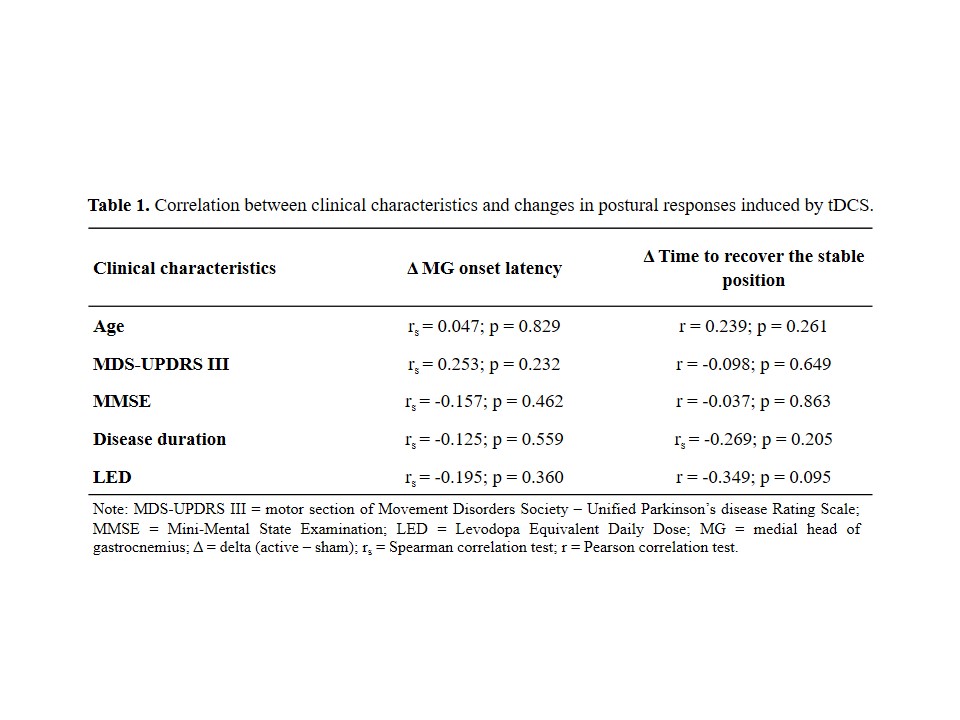Objective: To investigate the association between clinical characteristics and transcranial direct current stimulation (tDCS)-related changes in postural responses to external perturbations in people with Parkinson’s disease (PwPD).
Background: Postural response after external perturbation is impaired in PwPD. Our group recently showed that a single session of tDCS over the primary motor cortex improves postural response in PwPD, leading to shorter onset latency of medial gastrocnemius (MG) and time to recover the stable position [1]. However, the influence of baseline clinical characteristics on benefits achieved with tDCS remains unclear.
Method: Twenty-four PwPD participated in this study. As clinical characteristics we assessed age, disease duration, levodopa equivalent daily dose, the motor section score of the Movement Disorders Society–Unified Parkinson’s Disease Rating Scale, and the Mini-Mental State Examination. The tDCS protocols and postural control assessment were performed in two separate visits (~2 weeks apart). Stimulation protocol consisted of a single session of anodal tDCS over the primary motor cortex (2 mA, 20 min) and a single session of sham (active for only 10 s). The order of these sessions was counterbalanced across participants. PwPD performed 7 trials with the backward translation of the support base (20 cm/s and 5 cm) after both tDCS sessions. Time to recover the stable position and MG onset latency were determined using center-of-pressure and electromyography analysis, respectively. The delta (active – sham) of both parameters were calculated to determine the tDCS-related changes in postural responses. Pearson and Spearman correlation tests were applied to analyze the relationship between the tDCS-related change in postural responses (i.e. delta) and the clinical characteristics.
Results: No significant correlations were observed between clinical characteristics and tDCS-related changes in postural response [Table 1].
Conclusion: tDCS-related effects on postural response to perturbation seem to be similar in PwPD with different clinical characteristics. Future studies are necessary to identify the characteristics of tDCS responders which may optimize the clinical benefits achieved with tDCS in PwPD.
References: [1] Beretta VS, Vitório R, Nóbrega-Sousa P, Conceição NR, Orcioli-Silva D, Pereira MP, et al. Effect of Different Intensities of Transcranial Direct Current Stimulation on Postural Response to External Perturbation in Patients With Parkinson’s Disease. Neurorehabil Neural Repair 2020;34:1009–19.
To cite this abstract in AMA style:
V. Beretta, R. Vitório, D. Orcioli-Silva, N. Conceição, P. Nóbrega-Sousa, M. Pereira, L. Gobbi. Transcranial direct current stimulation-related changes in postural responses to perturbations are not influenced by baseline clinical characteristics in Parkinson’s disease. [abstract]. Mov Disord. 2021; 36 (suppl 1). https://www.mdsabstracts.org/abstract/transcranial-direct-current-stimulation-related-changes-in-postural-responses-to-perturbations-are-not-influenced-by-baseline-clinical-characteristics-in-parkinsons-disease/. Accessed December 24, 2025.« Back to MDS Virtual Congress 2021
MDS Abstracts - https://www.mdsabstracts.org/abstract/transcranial-direct-current-stimulation-related-changes-in-postural-responses-to-perturbations-are-not-influenced-by-baseline-clinical-characteristics-in-parkinsons-disease/

